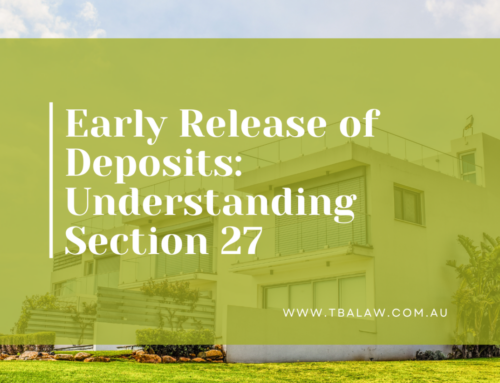Easy Conveyancing for Purchasers
by Sarah Coombs
Buying or selling a property can be a daunting process, but by following the 9 step conveyancing process detailed below, both vendors and purchasers can reduce stress and have a better understanding of what will happen during the course of the transaction.

Step One: Sale Documents
The vendor’s representative is charged with preparing sale documents according to the vendor’s instructions. They create a contract of sale a vendor statement on behalf of the vendor. Once the vendor is happy with the documents, they provide a blank copy of the contract and a signed vendor statement to the real estate agent or purchaser’s representative.
The purchaser’s representatives will review the sale documents prior to signing. They will then explain what the obligations will be under the contract and draw attention to any important matters disclosed in the Vendor Statement, such as planning regulations or current rates levied on the property. They will also advise if they believe there should be extra conditions added to best protect the purchaser’s interests.
Step 2: Signing the Contract
Once all parties are in agreement about what should be included in the contract, and other important matters such as the purchase price and settlement date, all parties sign the sale documents. Then the conveyancing process really starts. After the documents are signed they need to be provided to the legal representative ASAP so they can begin work on the next steps.
Step 3: Unconditional Contracts
It is common for contracts to be conditional upon the occurrence of another event. The most common of these is the purchaser having finance approved. Sometimes, a contract will be conditional upon the sale of another property, the registration of a plan of subdivision, an occupancy permit or pest and building inspections. The representatives make sure the relevant parties complete the tasks need to make sure that the contract becomes unconditional in the required time.
Step 4: Working with the Banks
The vendor’s representative will prepare the relevant documents to discharge the current mortgages and send them to the bank with all sale documents.
The purchaser’s representative provides the bank with the sale documents which are needed to finalise their loan. They ensure the purchaser have signed the mortgage documents with sufficient time to make the funds available for settlement.
Banks are sometimes to the slowest part about conveyancing, so you need a solicitor who will promptly attend to this, like we do.
Step 5: Stamp Duty
The vendor’s representative will prepare the relevant stamp duty forms with the basic information about the vendor and the property. They then send this to the purchaser’s representative, who adds information about the purchasers and any stamp duty concessions they may be eligible for. These forms are then sent electronically to all the parties to sign.
Step 6: Transfer of Land
The purchaser’s representative will prepare the Transfer of Land which is used to register the transfer of the land at the Land Titles Office and details the manner in which the purchasers will own the
property. This is most commonly done via the electronic settlement platform known as PEXA, however, is done in some circumstances physically. This is reviewed by the vendor’s representative to ensure that all details are correct.
Step 7: Adjustments and Final Figures
The purchaser’s representative prepares adjustments for the outgoings on the property- most commonly council and water rates. This ensures that each party pays for the portion of time that they own the property. This is then sent to the vendor’s representative who approves the figures.
Both sides prepare their respective Statement of Account. For the Vendor, this will detail where the proceeds of the sale will be directed. This commonly includes:
- Mortgage payout
- PEXA Fee
- Outstanding council and water rates
- Legal fees
- Vendor Funds
For the purchase, the Statement of Account will detail what needs to be paid at settlement. This commonly includes:
- Stamp duty
- Lodgement fees
- Legal fees
- Title insurance
- PEXA Fees
- Funds to the vendor
It will also detail how much the bank will provide, and how much you will need to provide, if any.
Step 8: Booking Settlement
All parties agree must agree to a settlement date and time and are required to be ready to settle by then. Each party ensures that their respective banks are prepared and that everyone is ready to execute settlement.
Step 9: Settlement
Settlement is when the property is legally transferred, and the money is paid. The purchaser’s funds will be taken from their account, or the mortgage drawn down on, and the vendor has the funds placed into their account (with electronic settlements, the funds normally appear within a matter of hours). The property is registered in the purchaser’s name, and they can collect the keys.
Find out more about our property services.






Leave A Comment